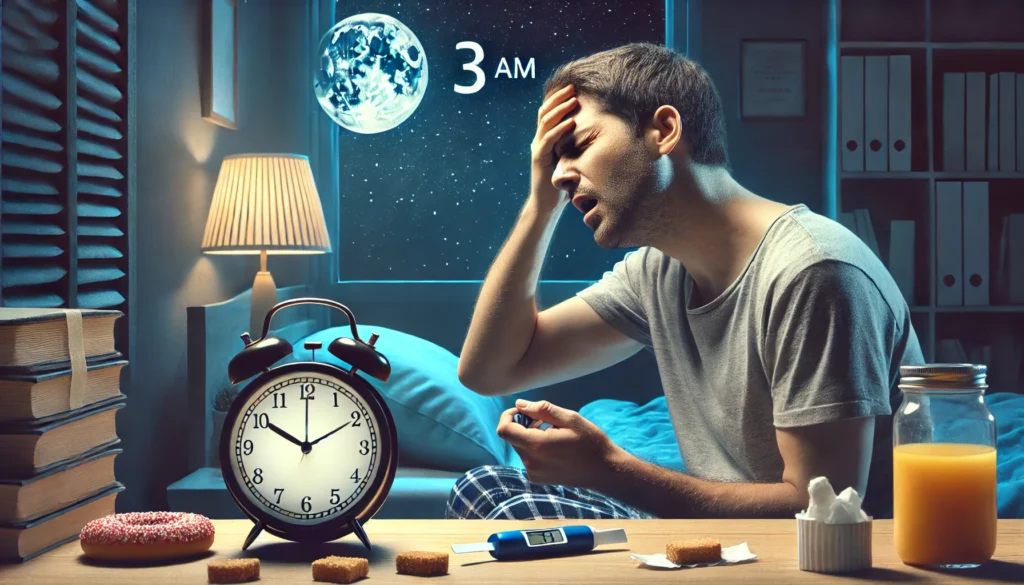Low blood sugar, or hypoglycemia, is commonly associated with diabetes. However, many people are surprised to learn that hypoglycemia can also occur in individuals without diabetes. This condition, often referred to as non-diabetic hypoglycemia, can lead to a wide range of symptoms and health concerns that merit closer attention. For many, it prompts the unsettling question: what causes low blood sugar without diabetes? The answers are multifaceted and rooted in complex biochemical, physiological, and lifestyle factors that affect glucose metabolism. Understanding the nuances of this condition not only brings clarity but also empowers individuals to seek proper care and make informed decisions about their health.
You may also like: How Diabetes Affects the Brain: Understanding Brain Fog, Memory Loss, and Mental Confusion from High Blood Sugar
Non-diabetic hypoglycemia may seem paradoxical at first—after all, blood sugar regulation is often discussed in the context of elevated glucose levels. Yet, the body’s glucose system is a delicate balance, and disturbances on either end of the spectrum can have profound implications. This article explores what hypoglycemia is, how it presents in people who do not have diabetes, what factors might be causing these symptoms, and the best approaches for hypoglycemia treatment when diabetes isn’t the underlying issue. We will also delve into how to raise blood sugar safely, examine common signs of low blood sugar, and address the question of whether low blood sugar causes nausea or other distressing symptoms. By unpacking the intricacies of this condition, we aim to provide a comprehensive, medically accurate, and engaging guide to a topic that remains under-recognized in both clinical and public health contexts.

Understanding Hypoglycemia: A Glucose Regulation Primer
To fully grasp what causes low blood sugar without diabetes, one must first understand how the body normally manages glucose. Glucose is the primary energy source for cells, particularly brain cells, which are highly sensitive to fluctuations. After eating, carbohydrates are broken down into glucose and absorbed into the bloodstream. In response, the pancreas releases insulin, a hormone that facilitates the uptake of glucose into tissues and helps lower blood sugar levels. Between meals, and especially during fasting, another hormone called glucagon stimulates the liver to release stored glucose, maintaining blood glucose levels within a healthy range.
Hypoglycemia occurs when this balance is disrupted, leading to a drop in blood glucose below the normal threshold—generally defined as a level below 70 mg/dL. While this cutoff can vary slightly between individuals and labs, it serves as a critical marker for initiating clinical concern. What is hypoglycemia if not a failure of this system? Either the body is producing too much insulin, failing to release enough glucose from the liver, or metabolizing glucose at an unusually fast rate. Identifying which mechanism is at fault is central to diagnosing and managing non-diabetic hypoglycemia.
It’s also essential to differentiate between hypoglycemia symptoms and hyperglycemia symptoms. Whereas symptoms of high blood sugar often include increased thirst, frequent urination, and fatigue, low blood sugar symptoms are marked by shakiness, sweating, dizziness, and cognitive impairment. In the absence of diabetes, these symptoms might be misattributed to anxiety, stress, or even neurological conditions, leading to delays in proper diagnosis and care. Recognizing the physiological context and triggers is key to understanding what causes low blood sugar in individuals who are not diabetic.
Types of Non-Diabetic Hypoglycemia: Reactive vs. Fasting
When examining what causes low blood sugar without diabetes, it is important to distinguish between the two primary types of non-diabetic hypoglycemia: reactive hypoglycemia and fasting hypoglycemia. These forms differ not only in timing and context but also in underlying physiology, which has implications for treatment and prevention.
Reactive hypoglycemia typically occurs within four hours after eating. It is thought to result from an exaggerated insulin response to a carbohydrate-rich meal, causing glucose to plummet rapidly after a transient spike. This condition is more common in people who have undergone gastric bypass surgery or have prediabetes, although it can also affect individuals with seemingly normal metabolic health. Reactive hypoglycemia symptoms may include lightheadedness, palpitations, irritability, and in some cases, confusion or blurred vision. The intensity and duration of symptoms can vary widely depending on the composition of the meal, individual insulin sensitivity, and co-existing hormonal factors.
In contrast, fasting hypoglycemia typically occurs after extended periods without food—such as overnight or during prolonged physical exertion. This form is often linked to underlying conditions such as liver disease, hormonal deficiencies, or tumors that secrete insulin or insulin-like substances. In children, fasting hypoglycemia is sometimes associated with metabolic disorders that impair the body’s ability to generate glucose. The sugar level being low in the morning might be an early clue pointing to this type. In adults, it may go unrecognized until significant symptoms develop, making early intervention all the more crucial.
Both forms of hypoglycemia without diabetes challenge the common assumption that only diabetics must worry about glucose regulation. Recognizing the timing and pattern of symptoms is essential in pinpointing the cause and developing a personalized hypoglycemia treatment plan. Whether reactive or fasting, these conditions require careful evaluation and often call for dietary modifications, lifestyle adjustments, and in some cases, further medical testing.

The Physiological and Hormonal Triggers of Non-Diabetic Hypoglycemia
Uncovering what causes low blood sugar in non-diabetics involves a deep dive into the intricate hormonal pathways that regulate glucose levels. While insulin is the most well-known player in glucose metabolism, several other hormones—including glucagon, cortisol, epinephrine, and growth hormone—play crucial roles in maintaining equilibrium. A deficiency or dysfunction in any of these systems can lead to hypoglycemia, even in the absence of diabetes.
One often overlooked cause is adrenal insufficiency, a condition where the adrenal glands fail to produce adequate cortisol. Cortisol is a counter-regulatory hormone that helps raise blood glucose during stress or fasting. Without it, the body becomes less capable of responding to low glucose levels. Similarly, growth hormone deficiency, though more commonly seen in children, can impair gluconeogenesis and glycogenolysis, leading to recurring episodes of hypoglycemia.
Pancreatic tumors, such as insulinomas, are rare but significant causes of chronic hypoglycemia without diabetes. These tumors secrete insulin independently of normal regulatory controls, leading to persistently low glucose levels. While rare, they serve as a potent reminder that not all hypoglycemia is benign or lifestyle-induced. In such cases, symptoms of low blood sugar in non-diabetics might include sudden fainting, unresponsive episodes, or even seizures if left untreated.
Additionally, certain genetic metabolic disorders can impair the liver’s ability to store or release glucose. Conditions like glycogen storage disease or fructose intolerance disrupt normal carbohydrate processing, resulting in low glucose availability. These are more common in pediatric populations but can persist into adulthood if not diagnosed early. Understanding these physiological triggers is vital in piecing together the puzzle of hypoglycemia without diabetes and guiding appropriate medical investigation.
Dietary Patterns and Lifestyle Factors That Influence Blood Sugar
Beyond hormonal and genetic factors, lifestyle and dietary habits can significantly impact glucose regulation. For individuals without diabetes, what causes low blood sugar often ties back to what, when, and how they eat. Skipping meals, consuming excessive simple carbohydrates, or following restrictive diets can all contribute to blood sugar instability. For example, a high-sugar breakfast followed by several hours without eating can lead to a spike-and-crash scenario, where insulin drives down glucose too rapidly, resulting in reactive hypoglycemia symptoms.
Alcohol consumption is another common yet underappreciated contributor to low blood sugar in non-diabetics. Alcohol inhibits gluconeogenesis—the process by which the liver produces glucose—particularly in the fasting state. As a result, even moderate drinking can lead to symptoms of hypoglycemia the morning after, especially if food intake was insufficient. This explains why some individuals may wake up feeling dizzy, weak, or nauseated, unsure whether the cause is alcohol-related or a more serious underlying issue.
Exercise also plays a complex role in glucose metabolism. While physical activity generally supports healthy blood sugar control, intense or prolonged exercise without adequate nutrition can lead to hypoglycemia. This is especially true for endurance athletes or individuals who engage in intermittent fasting. Recognizing the balance between energy expenditure and intake is essential to prevent low blood sugar symptoms during or after workouts.
Sleep patterns and stress levels also influence glucose regulation. Poor sleep can impair hormonal rhythms and insulin sensitivity, while chronic stress can elevate cortisol, sometimes leading to a rebound drop in glucose levels after the stress response abates. These lifestyle-related influences often operate in tandem, creating a cumulative effect that may predispose individuals to hypoglycemia without any overt medical diagnosis.
Recognizing the Signs of Low Blood Sugar in Non-Diabetics
Identifying the symptoms of low blood sugar in non-diabetics requires a high level of awareness and attention to detail. Because many people do not associate hypoglycemia with individuals who do not have diabetes, early warning signs may go unnoticed or misinterpreted. The classic signs of low blood sugar include shakiness, sweating, rapid heartbeat, dizziness, and irritability. As blood sugar continues to drop, more severe symptoms such as blurred vision, confusion, and loss of consciousness may occur.
Understanding what low blood sugar feels like is crucial for timely intervention. Many people describe it as a sudden, overwhelming wave of weakness, paired with difficulty thinking clearly and a sense of impending doom. These descriptions may overlap with anxiety or panic attacks, making it difficult to distinguish between the two without measuring blood glucose levels. Therefore, anyone experiencing these symptoms—especially if they occur after eating or after fasting—should consider checking their glucose levels or consulting a healthcare provider.
In some cases, the body’s normal warning signals for hypoglycemia may be diminished or absent, a condition known as hypoglycemia unawareness. This is particularly dangerous because it delays corrective action until the individual becomes severely impaired. Recognizing subtle signs and keeping a symptom diary can help detect patterns and prompt medical evaluation. It’s also vital to understand that while low blood sugar not related to diabetes may seem less urgent, its impact on cognitive function, physical performance, and quality of life can be profound.
There’s also the question of whether low blood sugar causes nausea. Indeed, nausea can be a common symptom, especially when hypoglycemia is accompanied by a stress response that activates the sympathetic nervous system. This response can slow digestion and cause queasiness, compounding the discomfort of an already disorienting episode. Knowing that nausea can signal falling glucose levels may help individuals act quickly to prevent more serious consequences.
Navigating Non-Diabetic Hypoglycemia: A Call for Awareness and Action
In a healthcare landscape often dominated by discussions of high blood sugar and diabetes, non-diabetic hypoglycemia remains an underappreciated yet impactful condition. Understanding what causes low blood sugar without diabetes requires a broad perspective—one that includes hormonal imbalances, genetic predispositions, dietary patterns, stress responses, and lifestyle factors. When left unrecognized, the symptoms of low blood sugar in non-diabetics can significantly impair daily functioning and long-term health.
One of the greatest challenges lies in the subtlety and variability of hypoglycemia symptoms, which often mimic other common conditions like anxiety, dehydration, or fatigue. This ambiguity can delay diagnosis, making it critical for both healthcare providers and individuals to maintain a high index of suspicion when symptoms such as dizziness, confusion, or unexplained fatigue arise—especially after eating or prolonged fasting. When asking what is a low blood sugar level, the answer may vary between individuals, but a consistent pattern of symptoms paired with readings below 70 mg/dL warrants further attention.
Fortunately, increased awareness can lead to effective prevention and treatment strategies. Dietary changes, such as eating smaller, balanced meals at regular intervals and avoiding simple sugars, can go a long way in stabilizing glucose levels. Knowing how to raise blood sugar safely using complex carbohydrates or glucose tablets can also prevent episodes from becoming severe. For those experiencing reactive hypoglycemia symptoms or fasting-induced drops in glucose, seeking medical evaluation to rule out underlying conditions like insulinomas or adrenal insufficiency is essential.
Moreover, understanding how to raise glucose levels during an episode is just as important as recognizing the early signs. Immediate interventions—such as consuming a quick source of glucose—can prevent escalation and restore mental clarity. For more persistent or severe cases, exploring options for long-term hypoglycemia treatment may involve hormone testing, imaging studies, or consultations with specialists in endocrinology or metabolic health. It’s essential to tailor these interventions to the individual, as there is no one-size-fits-all approach.

Frequently Asked Questions (FAQ) on Blood Sugar Regulation
1. What are the most common symptoms of high blood sugar, and how can they affect daily life?
Symptoms of high blood sugar, also known as hyperglycemia symptoms, can range from mild to severe. Frequent urination, excessive thirst, blurred vision, and fatigue are among the earliest warning signs. Over time, prolonged high blood sugar can impair cognitive function, making it harder to concentrate or recall information. Additionally, it can lead to nerve damage, affecting sensation in the hands and feet, and increase the risk of infections. If left unmanaged, hyperglycemia symptoms may contribute to long-term complications such as kidney disease, heart issues, and vision impairment.
2. Can you have low blood sugar without diabetes, and what causes it?
Yes, low blood sugar without diabetes is possible and is referred to as non-diabetic hypoglycemia. This condition may result from prolonged fasting, excessive alcohol consumption, or an overproduction of insulin. Additionally, certain medical conditions, such as hormonal imbalances or liver disease, can contribute to blood sugar dips. Individuals who experience reactive hypoglycemia symptoms may notice that their blood sugar drops a few hours after eating, particularly if their diet is high in refined carbohydrates. Proper dietary adjustments and balanced meals can help prevent episodes of low blood sugar not diabetic individuals might experience.
3. What does low blood sugar feel like, and how does it impact physical and mental health?
Low blood sugar symptoms can vary from person to person, but they often include dizziness, shakiness, sweating, confusion, and irritability. More severe cases may cause heart palpitations, seizures, or loss of consciousness. Mentally, hypoglycemia symptoms can make it difficult to focus, leading to mood swings, anxiety, and even depression. Experiencing frequent drops in blood sugar can significantly impact a person’s ability to perform daily tasks safely, especially when driving or operating machinery. Understanding what is hypoglycemia and learning to recognize early warning signs can prevent serious health risks.
4. What are 5 signs your blood sugar is too high, and when should you seek medical attention?
The five most common signs of hyperglycemia include excessive thirst, frequent urination, extreme fatigue, blurred vision, and unexplained weight loss. While occasional fluctuations in blood sugar may not be a cause for concern, consistently high levels warrant medical intervention. Prolonged hyperglycemia can lead to dehydration, increase the risk of infections, and cause damage to blood vessels. If symptoms of high blood sugar persist despite lifestyle changes, or if ketones are present in the urine, immediate medical attention is necessary. Early management can help prevent complications such as diabetic ketoacidosis (DKA), which can be life-threatening.
5. How to raise blood sugar immediately if you experience a sudden drop?
If your sugar level low in the morning or at any time of the day, quick action is required. Consuming fast-acting carbohydrates like fruit juice, glucose tablets, or a spoonful of honey can help restore normal levels within minutes. If low blood sugar while sleeping occurs frequently, keeping a snack by your bedside may prevent nighttime dips. After consuming sugar, it’s important to follow up with a protein-rich meal to maintain stable blood sugar levels. For those with recurrent hypoglycemia symptoms, working with a healthcare provider to adjust diet and lifestyle habits is essential.
6. What causes high blood sugar, and how can it be managed effectively?
Several factors can contribute to high blood sugar levels, including excessive carbohydrate intake, stress, lack of physical activity, and certain medications. Underlying conditions such as insulin resistance or hormonal imbalances may also play a role. Long-term management involves adopting a balanced diet, engaging in regular physical activity, and monitoring blood sugar levels closely. For individuals with type 2 diabetes hypoglycemia episodes may occur as a side effect of medication, making it crucial to balance treatment with appropriate dietary intake. Implementing stress-reducing techniques such as meditation or yoga can also help stabilize blood sugar fluctuations.
7. What are the signs of low blood sugar, and how do they differ from other conditions?
Signs of low blood sugar include sweating, rapid heartbeat, dizziness, and hunger. These symptoms can sometimes be mistaken for anxiety or panic attacks. In severe cases, confusion, slurred speech, and fainting can occur, resembling symptoms of other neurological conditions. Unlike hyperglycemia, which develops gradually, hypoglycemia symptoms can appear suddenly and require immediate action. Understanding what is a low blood sugar level and how to address it can prevent serious consequences, especially for individuals who experience hypoglycemia without diabetes.
8. Does low blood sugar cause nausea, and how can it be relieved?
Yes, hypoglycemia can lead to nausea due to the body’s stress response when blood sugar levels drop. Other digestive symptoms, such as stomach pain and lightheadedness, may accompany nausea. Eating a small, balanced meal that includes complex carbohydrates, protein, and healthy fats can help stabilize blood sugar and reduce discomfort. Avoiding excessive caffeine and alcohol consumption can also prevent nausea-related episodes. If nausea frequently occurs with other low blood sugar symptoms, a medical evaluation may be necessary to rule out underlying conditions.
9. How to raise glucose levels and prevent future drops?
To raise glucose levels quickly, consuming simple carbohydrates such as fruit juice, candy, or glucose gels is effective. However, preventing recurrent drops requires a long-term strategy. Eating smaller, more frequent meals that contain fiber, protein, and healthy fats can help maintain stable blood sugar levels throughout the day. For those experiencing reactive hypoglycemia symptoms, reducing intake of refined sugars and processed foods can minimize sudden blood sugar crashes. If low blood sugar symptoms in non-diabetics persist, keeping a food and symptom diary may help identify patterns and triggers.
10. What happens if my blood sugar is too low for an extended period?
Severely low blood sugar levels can lead to life-threatening complications, including seizures, loss of consciousness, and brain damage. Prolonged hypoglycemia can also impair cognitive function and increase the risk of accidents and injuries. Individuals who experience frequent episodes should consider carrying emergency glucose sources, such as dextrose tablets or a glucagon injection. If hypoglycemia is left untreated, it may also increase the risk of developing insulin resistance over time. Regular monitoring and proper hypoglycemia treatment can prevent long-term health consequences and ensure overall well-being.
Conclusion:
As we continue to explore the complex landscape of blood sugar regulation, it becomes increasingly clear that hypoglycemia without diabetes is not only real but deeply deserving of more research, recognition, and empathy. Whether it’s understanding what causes high blood sugar, what is hyperglycemia, or asking which of the following is not a sign of hyperglycemia, we must expand our knowledge base to include both ends of the glycemic spectrum. Ultimately, by fostering a greater understanding of non-diabetic hypoglycemia and empowering individuals with knowledge and tools for self-care, we can improve outcomes, enhance quality of life, and ensure that low blood sugar not diabetic is no longer a mystery but a manageable, navigable aspect of holistic health care.
glucose metabolism regulation, non-diabetic low blood sugar, insulin overproduction, reactive hypoglycemia causes, fasting glucose drop, adrenal hormone imbalance, cortisol and blood sugar, liver glucose release, hypoglycemia in healthy adults, hormone-related hypoglycemia, early warning signs of hypoglycemia, low blood sugar during exercise, morning glucose dip, how to manage blood sugar naturally, hypoglycemia nutrition strategies, blood sugar and mental clarity, glucose imbalance symptoms, metabolic causes of hypoglycemia, liver function and blood sugar, how stress affects glucose levels
Further Reading:
What Causes Low Blood Sugar Without Diabetes?
Disclaimer: The content published on Better Nutrition News (https://betternutritionnews.com) is for informational and educational purposes only. It is not intended as a substitute for professional medical advice, diagnosis, or treatment. Always seek the guidance of a qualified healthcare professional before making any changes to your diet, nutrition, or wellness practices. The opinions expressed by authors and contributors are their own and do not necessarily reflect those of Better Nutrition News.
Better Nutrition News and its affiliates make no representations or warranties regarding the accuracy, completeness, or reliability of the information provided. We disclaim all liability for any loss, injury, or damage resulting from the use or reliance on the content published on this site. External links are provided for reference purposes only and do not imply endorsement.



